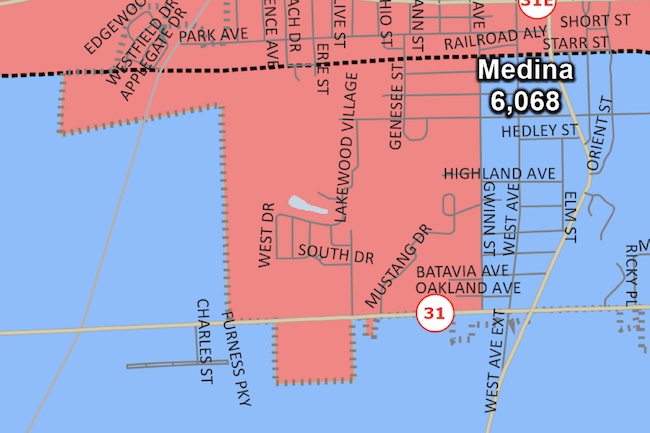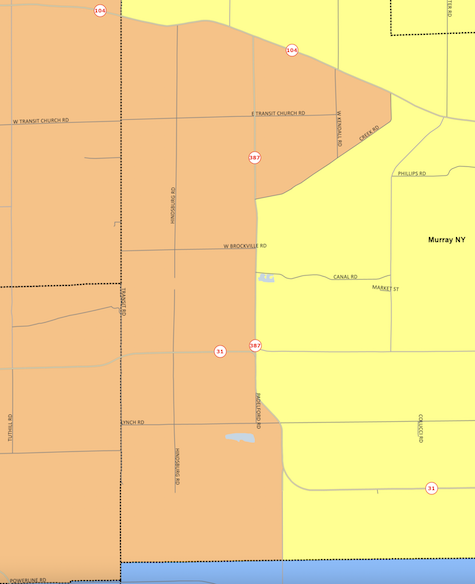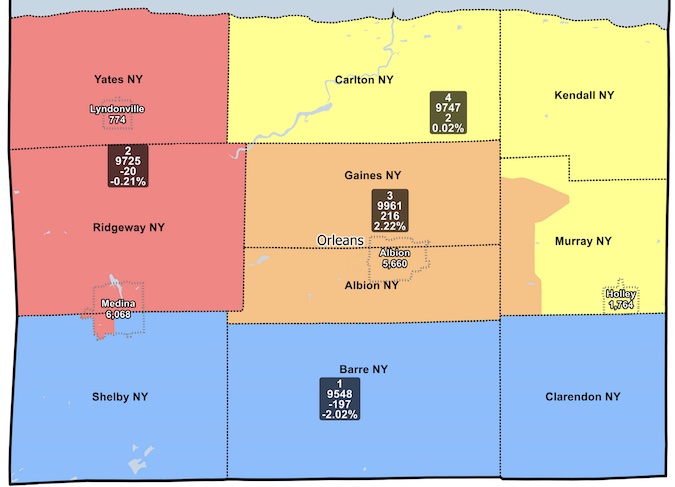County unveils redistricting map for Legislature
Part of Albion-Gaines district shifts into western part of Murray
ALBION – Orleans County officials are proposing redistricting changes to bring four County Legislature districts into nearly the same size after population changes created too much of a disparity among the districts.
The districts are allowed to have up to 5 percent variance in population. But the current districts, without changes, are at 11.7 percent deviation, which is out of compliance with state and federal law.
The county worked with Skyline Demographic Consultants, Inc. to bring the four legislative districts within an acceptably close size. Click here to see a high resolution map.
The county is looking to add part of western Murray to a district that currently is the towns of Albion and Gaines. That gives the Albion-Gaines (District 3) more people and also takes away from District 4 that includes Murray, Kendall and Carlton.
The Murray section going to District 3 includes 522 people from Murray’s election district 5.
During the last redistricting about a decade ago, the county added a small part of Shelby to District 2 that included Yates and Ridgeway. This time the county is looking to move more of that area back into District 1, the Shelby-Barre-Clarendon district. That represents a shift of 418 people, said Jack Welch, the county’s chief administrative officer.
The County Legislature next meets on Jan. 24 and expected to set a public hearing on the changes for Feb. 9.

This shows the proposal for the section of Shelby in red that would be included in the Yates-Ridgeway District and the section in blue that would be in the district that includes Barre, Clarendon and most of Shelby.
There are also three at-large countywide positions that Welch said don’t need any changes because they represent the same population – the entire county. Those positions include an at-large legislator from the western end (towns of Yates, Ridgeway and Shelby), at-large from central (Albion, Gaines, Carlton and Barre) and at-large from the east (towns of Kendall, Murray and Clarendon).
“The three at-large districts had no boundary changes since they are the entire county,” Welch said. “The east, west and central only pertains to where the candidates come from and not about who can vote for the candidates. All registered voters in Orleans County may vote for the at-large legislator candidates.”

The orange part of Murray would be shifted into a district that includes Albion and Gaines, while the yellow would be in a district that includes Carlton, Kendall and most of Murray.
County officials are pushing to get the boundaries set for the four other districts because it is getting close to the start of the election cycle. The primary schedule has been moved up from September to June.
Candidates will soon be interviewing with political party leaders to run for the positions, and candidates need to get petitions signed to get on the ballot for a primary and the general election.
The Orleans County Democratic Party has filed a legal challenge for the County Legislature to do redistricting and bring the districts into balance. Welch said the county was working on redistricting before the lawsuit from the Democrats.
The county’s population in the 2020 census was 40,343 people. That census block population shows 1,456 incarcerated people at two state prisons in Albion. Those people are to be reallocated to their home counties for redistricting purposes, Welch said.
The state Legislative Task Force on Demographic Research and Reapportionment (LATFOR) lists the three census blocks where the prisons are located as a negative 76 population. That doesn’t make sense to Skyline Demographic Consultants because there aren’t any residential structures in those blocks, outside of the prisons. The firm recommended the county zero out those blocks, instead of doing a negative-76.
County officials are taking out the 1,456 population for the prisons. That number has then been subtracted from the 40,343 in the census and with another small adjustment the total for the county is 38,891 for redistricting. Dividing that by the four legislative districts puts the ideal district at 9,745.
State law allows a 5 percent deviation. A plus or minus of 2.5 percent from the ideal would be 245 people.
The redistricting proposal puts the deviation at a maximum of 4.2 percent, with District 1 down by 2.02 percent from the ideal and District 3 at 2.22 percent over the ideal.
District 1 with most of Shelby, all of Barre and Clarendon would be 9,548 people, or down 197 people or 2.02 percent from the ideal.
District 2 with Yates, Ridgeway and small portion of Shelby would be 9,725, or 20 fewer than the ideal or under by 0.21 percent.
District 3 with Gaines, Albion and part of western Murray would be a population of 9,961, which is over the ideal by 2.22 percent or 216 people.
District 4 with Carlton, Kendall and most of Murray would total 9,747 people, only 2 more than the ideal or off by just 0.02 percent.
The redistricting changes would move 940 people into different districts, which is 2.4 percent of the population, Welch said.
Without redistricting, the deviation would be 11.7 percent. The current District 1 is 6.3 percent under the ideal, while District 2 is 4.1 percent over, District 3 is 3.1 percent below and District 4 is 5.4 percent above the ideal.
Some of the criteria from the state for redistricting include the following:
- Districts shall not be drawn with the intent or result of denying or abridging the equal opportunity of racial or language minority groups to participate in the political process or to diminish their ability to elect representatives of their choice.
- Districts shall consist of contiguous territory.
- Districts shall be as compact in form as practicable.
- Districts shall not be drawn to discourage competition or for the purpose of favoring or disfavoring incumbents or other particular candidates or political parties.
- The maintenance of cores of existing districts, of pre-existing political subdivisions including cities, villages, and towns, and of communities of interest shall also be considered. To the extent practicable, no villages or cities or towns except those having more than forty percent of a full ratio for each district shall be divided.
- Districts shall be formed so as to promote the orderly and efficient administration of elections.








































































